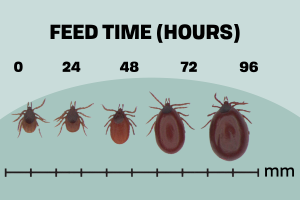Regardless of the type of tick, the life cycle and purpose in life are the same. They will be on the lookout for a host they can attach to and feed on. Tick’s bite is painless and you will not feel when it happens. What you feel is the itching caused by the feeding process. It’s also a delicate job to get a tick out of an animal or a human skin.
Ticks on dogs. What are the symptoms?
Are there any symptoms of a dog having a tick? Well, the most common sign of having a tick is the itching which is caused by the irritation, there can also be redness around the affected area. Scratching and biting more than usual should be your first sign to take a look at your dog.
There are also some serious health signs or effects that you may notice too late. They include hypersensitivity, anaemia (from the blood loss), or systemic illness if the tick was infectious.
Some tick species have managed to suppress their host’s response to their bites.
If you notice your dog scratching or biting itself more than the usual after an outing, check it for ticks right away. If a dog is allergic to ticks it will be even more irritated. It can even harm itself by biting too hard, or worse, tore the tick in two and the head can remain inside its body and cause a severe infection.
Keep in mind that the tick may be small and hard to see. You need to carefully examine your dog on a daily basis.
There can also be internal symptoms including fever, lethargy, loss of appetite, tick paralysis. Tick-borne diseases can cause problems to the gastrointestinal system, immune system.
How to check for ticks?
Checking your pet for ticks should not be rushed. Otherwise you risk to accidentally remove the wrong half of the tick. Gently caress your pup and lookout for suspicious irregularities and bumps, paying special attention around its eyes, armpits, toes, tail, ears, neck. Get a bowl of rubbing alcohol and a pair of tweezers.
“If you find a tick crawling your pet quickly grasp it with the tweezers and put in the rubbing alcohol where it will die. If the tick is already feeding on your pet, and you are not certain about removing it safely on your own, you should seek professional help.” says Dean Signori.
After removing a tick from your pet you should consider a blood test to make sure of its health.
How to get rid of ticks naturally?
Are there some natural methods to keep ticks away from both pets and humans? Supposedly, there are.
1. Apple Cider Vinegar can be given to a dog because it will make its blood more acidic which will repel ticks, and fleas as well. As anything in life, overdosing is unhealthy but adding two spoons per a litre of water is okay.
2. Garlic can help, Of course, small amounts. And yes, you can give it to your dog. Small amounts can be added to the dog’s food as part of prevention. When garlic is processed and enters its blood system, the entire body will emit a specific scent that repels both ticks and fleas.
3. External methods to repel ticks can also be non-toxic. There is a variety of herbal collars, sprays, and powders that will get the job done. You can also make one on your own. Mixing a few essential oils (2 tablespoons of rose geranium oil and almond oil) and adding a few drops to the dog’s collar is also very efficient.
Furthermore, you can drop a few drops in your dog shampoo as well.
4. Make a citrus repellent spray by cutting a lemon into pieces and boiling it with water. Let sit for the night and the next day sprinkle your dog with the lemon water around the head and armpits.
How to get rid of ticks on dogs?
Removing ticks from dogs should not be done without adequate preparation. Even if you have seen the removal of a tick before, you should still refresh your know-how and bear in mind the need of the following:
- Rubber gloves;
- Tweezers;
- Rubbing alcohol or vodka;
- A jar or white cloth and matches.
Step one. Preparations. Sterilise your tweezers with rubbing alcohol. Use rubber gloves to protect yourself from the tick.
Step two. Try to restrain and keep your dog calm. If it is necessary, give it something to eat while you try to get the tick out, or ask a second person to hold it down tight. Also, be careful because your dog will most-likely get nervous.
Step three. Trying not to pinch the dog, grasp the tick as close to the dog’s skin as possible. Careful not to twist!
Step four. Pull the tick out. By holding it firmly and without twisting pull out the tick. Do not squeeze too hard because you may pull it out without its head. If the tick came out whole, put it in the rubbing alcohol or vodka to kill it and close the lid of the jar.
Step five. Disinfect the area. By using an antibiotic ointment, antiseptic wipes or a little bit of the rubbing alcohol you can disinfect the bite mark to prevent an infestation. Keep monitoring the area in the following days and if you see it become more red consult a vet.
How to get rid of ticks on puppies?
Removing a tick from a puppy is not an easy job because you cannot treat the puppy like an adult dog. No pesticides or a collar can be used on a puppy and it makes the job of protecting it harder. Read above what repels ticks naturally.
What you should do is pet the puppy and see if you find any bumps, or inspect its body, paying attention near the ears, neck, eyes, paws. Luckily, you will find ticks before they have dug their head into your puppy or not find any ticks at all. However, it is not always the best case scenario and sometimes there might be one hiding.
How can you get rid of ticks on your puppy without using pesticides? The simplest way is to use a pair of tweezers and try to remove it on your own. If you have mineral oil you can soak the tick in it before grasping it with the tweezers. Hold the tick’s head if possible or near it and try to not squeeze too hard. You must get the entire tick out. Make sure to pull it out gently.
After the tick is out, put it rubbing alcohol to kill it. Also, give your puppy a dog treat.
How to get rid of ticks in dogs ears?
Ticks tend to attach to dogs years quite a lot and since it is a gentle area, you should be very careful when you are removing a tick. What you will need:
- Tweezers or a tick remover;
- A bowl of rubbing alcohol;
- Rubber gloves;
- Cotton swabs.
How to remove a tick from your dog’s ear: grasp the tick at the closest point where it is attached to your dog. Be firm but careful because you have to get the entire tick out and not have the head removed and burrowed under the skin. Pull the tick without twisting it until it is out and put it in the bowl of rubbing alcohol right away. The rubbing alcohol will kill the tick right away, also dip a cotton swab in it and apply it to your dog’s ear to relieve the itching and prevent an infection.
How to get rid of ticks in a carpet?
1. Find and mark the areas where you think there are ticks or eggs, mainly areas where your pet spends a lot of time.
2. Vacuum thoroughly in straight lines, make sure not to miss anything. Pay more attention to areas where you have noticed ticks. When you are done vacuuming, place the vacuum bag in a zip storage bag, zip it and throw it outside of the house.
3. Wash all textiles in the room at high temperature. Including clothing, seat covers, pillows or cushions, table cloth, curtains. If possible, put them in a dryer as well.
4. Then sprinkle salt all over your carpet, concentrating on areas where you suppose the ticks are most likely to hide. Leave the salt overnight and vacuum again the next day. Repeat the disposing of the vacuum bag. Seal it tightly and throw away from the house.
5. If some textile coverings cannot be removed, steam clean them, including the carpet. A steam cleaner, if you don’t have one, can be borrowed, rented or bought.
6. If nothing seems efficient enough, use pesticides. 24/7 Pest Control recommends you always remove pets and family from the treated area. Also keep everybody away for at least 48 hours. In case of doubt you can always as for further advice.
7. After treating the carpet and surrounding area, leave the house and let the pesticides do their work at least 24 hours. Come back and vacuum the carpet and dispose of the vacuum bag, as mentioned above.




